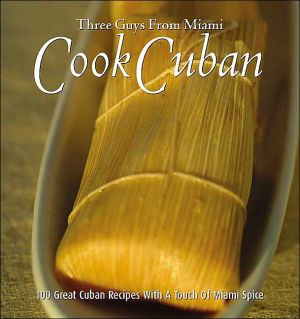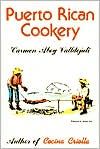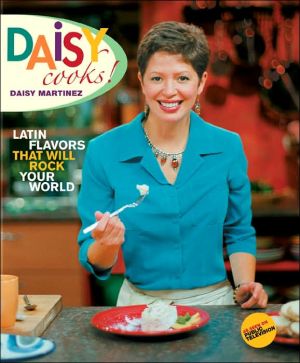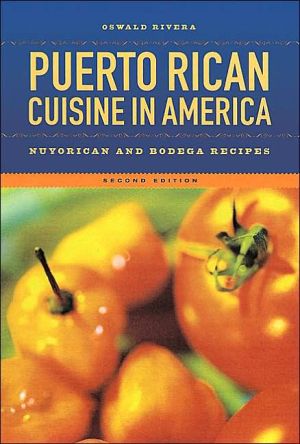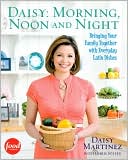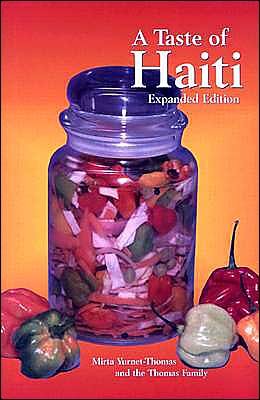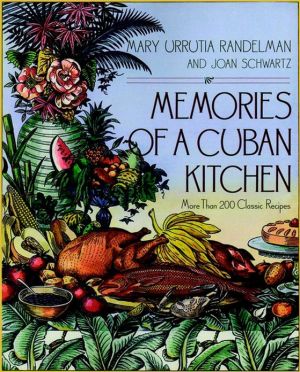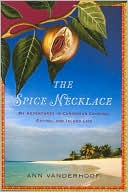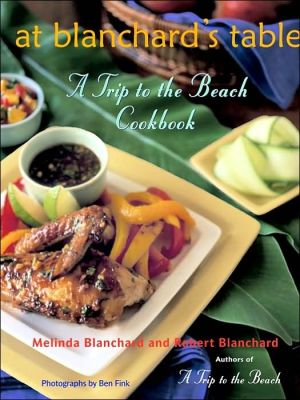Three Guys from Miami Cook Cuban: 100 Great Recipes With a Touch of Miami Spice
From simple Cuban fare like frijoles and tamales, to elaborate dishes like a rich, seafood-packed paella, this hot recipe book is packed with Miami Cuban spice and local color. If you can't get to Miami for a Cuban sandwich, the next best thing is making your own-or maybe it's even better. One thing is certain: the Three Guys will make the experience both fun and memorable.\ Enter the sensational world of Cuban cuisine, which blends the spices of Spain, the tropical tastes of the Caribbean, a...
Search in google:
Written by the trio that has spawned a renewal of interest in Cuban cuisine, this guide to the flavors of Cuba reveals the island as a tasty confluence of Spanish spices, tropical ingredients, and African influence. Publishers Weekly This cookbook boasts solid renditions of Cuban dishes, but readers will have to suffer through the cheesy repartee among its three authors, who have a Cuban culture Web site, www.iCuban.com. A brief introduction entices with information about Cuban migration to Miami, but margin notes to the recipes tend toward repetitious and obvious exchanges. A recipe for Fried Stuffed Potatoes, for example, begins with Ra l commenting, "This is one Cuban snack that if you haven't tried, you probably don't know what in the heck it is." Still, the food itself is alluring. Avocado and Pineapple Salad is refreshingly unusual, and marinating Cuban-Style Skirt Steak in a mix of onion, herbs and sour orange juice before grilling delivers maximum flavor with minimal work. The authors nicely cover savory snacks like Cornmeal Pancakes, numerous types of empanadas, and Plantain Chips. They also remain true to authentic Cuban cuisine by not skimping on the frying, though fat-phobic Americans will probably avoid the Fried Pork Chunks. Occasionally the recipes slip into a cutesy tone (one for Cuban Bread cheerleads, "it's a little sticky, but you can do it!" then begins a later step with, "When you return from the pool..."). Overall, this effort stands out less because of its appeal than because it has so few competitors. (Nov.) Copyright 2004 Reed Business Information.
Introduction\ Welcome to our first cookbook. If you are one of the more that two million people who have visited our Web site at iCuban.com: The Internet Cuban, you already know who we are. If you are one of the more than six billion people alive today who have not, a little explanation is in order. We are the Three Guys from Miami-three guys who share a passion for good food, good conversation, and a great party.\ We are not classically trained chefs. We have, however, been cooking and eating Cuban food all of our lives-except for Glenn. He's only been cooking and eating it for twenty-three years, but he's working real hard to catch up! Are we experts? We'd certainly like to think so, but how can we be experts when we are learning something new every day? What we can say is that there is no one more dedicated to Cuban food and we have the waistlines to prove it!\ If you are new to Cuban cuisine, you are about to enter a new world of flavor. Cuban cooking combines the tastes of Spain with the tropical flavors of the Caribbean. Throw in some New World spices and ingredients and a strong African influence and you have the essence of Cuban cookery. Cuban food is highly spiced but NOT spicy hot. Cubans just don't use the hot peppers that are such an integral part of many Latin American cuisines.\ Our recipes also reflect, quite naturally, ingredients and methods that were refined by Cuban exiles after they came to the United States. Here they found an abundance of foods that were either very scarce or completely unavailable in Castro's Cuba. Fish and seafood are two examples of foods that were only rarely enjoyed in Cuba after 1959. It was also impossible to get real olive oil-an ingredient that gives so many Cuban dishes a distinctive Latin flavor. Exile in the U.S. also exposed Cubans to ingredients they never saw in Havana. Salmon is very popular with Miami Cubans, for example, but unheard of back home in Cuba.\ This cookbook represents three lifetimes of enjoying Cuban food and a long process of creating, collecting, and refining the recipes we present here. These are the Cuban food favorites that we have cooked and eaten in our own homes for many years. Many of our recipes are based on longtime family recipes from several generations of the Musibay and Castillo families. In all cases we present our dishes as they are enjoyed today by Cubans in Miami. Although we have added our own twists over the years, our recipes are rooted in the classic dishes of Cuba. You won't find any "Nuevo Latino" or Pan-Latin recipes here!\ Wherever possible we have made these dishes simple to prepare. You don't need to be a professional chef to create any of the recipes in this book. You also won't find a lot of esoteric, hard to find, or expensive ingredients such as truffle shavings, couscous, arugula, or anything in aspic! Best of all, you don't need to be Cuban to cook and enjoy these delicious recipes. If a Swedish guy from Minnesota can cook Cuban food (and he does it very well), you can too!\ We must also acknowledge Nitza Villapol, the "Betty Crocker of Cuba." We can't agree with her political outlook, but she helped standardize Cuban recipes for the masses. In the 1950s, every new Cuban bride received a copy of her cookbook. Everyone cooking Cuban food today is indebted to her pioneering efforts in collecting Cuban recipes. In fact, several of the dishes we prepare today have their roots in her early work. Just about every home in Miami has a tattered copy of this Cuban food bible. Raúl's wife, Esther, still uses her copy faithfully.\ Finally, we owe a debt of gratitude to the many visitors to our Web site from around the world who have helped us with recipe ideas and suggestions, questions and comments that have inspired us to do better, and complaints when a recipe just didn't turn out like it should have. Their encouragement and appreciation have been our inspiration.\ So thank you so much for purchasing our book! We hope that you and your family enjoy these delicious dishes!\ Three Guys From Miami\ Glenn Lindgren\ Raúl Musibay\ Jorge Castillo\ August 2004\ For more information about Cuban food and culture, visit the authors' Web site-iCuban.com: The Internet Cuban-at http://www.icuban.com, or better yet, send them an e-mail at 3guys@icuban.com.\ Sample recipes:\ Arepas-Cornmeal Pancakes\ Glenn: Arepas are delicious little cornmeal pancakes, a very popular treat on street corners in Colombia.\ Raúl: You also see them all over Miami! They are very popular at festivals and other events.\ Glenn: The traditional arepa served at lunch counters in Miami has two cornmeal pancakes with a layer of cheese inside. The pancakes are slightly sweet and have a delicious corn flavor. They're usually smeared with butter and cooked on a griddle until they're lightly browned and crisp.\ Jorge: Most restaurants use a mild mozzarella or Swiss cheese. We've had good luck with a baby Swiss-the one without the holes.\ Glenn: You can also use Monterey Jack with good results.\ Ingredients-\ 1 cup milk\ 5 tablespoons butter\ 1 cup frozen corn kernels\ 1 cup arepa flour, or 1 cup finely ground yellow cornmeal\ 1/4 teaspoon salt\ 1/3 cup sugar\ 1 cup grated mozzarella cheese\ 1/2 cup water (approximately)\ Mild Swiss, mozzarella, or Monterey Jack cheese, sliced\ Bring the milk to a boil in a small pan. Add butter. Let stand and cool slightly.\ Grind frozen yellow corn kernels in a food processor. You can find arepa flour at many Latin and Mexican markets. If there isn't one near you, use finely ground yellow cornmeal. In a large bowl, mix the ground corn, arepa flour or cornmeal, salt, sugar, and mozzarella. Make a well in the center and gradually add the hot milk and butter mixture. Stir until there are no lumps. Work the dough until it is smooth and sticky. Add water as necessary if the dough is too thick.\ Place dough on a lightly floured surface and use a rolling pin to roll it out to about 1/2 inch thickness. Cut out the arepas with a large cookie cutter-about 3 inches in diameter. (We've had good luck using a small straight-edged bowl.)\ Heat a lightly buttered griddle to medium. Cook the arepas in batches until crispy and golden brown on each side. Immediately place a slice or two of cheese on one arepa and cover with another to make a sandwich. Reduce heat to low and continue cooking until the cheese melts, flipping a few times.\ You may also make the pancakes only and store them in the refrigerator or freezer until ready to serve. Just lightly butter two pancakes, put a slice of cheese in between, and heat on the griddle at low heat until the cheese melts.\ TIP: We also have made these by thinning out the batter slightly with a little water so that it can be spooned directly onto a griddle, like a pancake. This saves all the work of rolling out and cutting!\ Serves 6 to 8
Table of ContentsIntroductionDrinksCafe Cubano-Cuban CoffeeCuba Libre-Rum and CokePonche Habana Para Los Ninos-Havana Punch for KidsMojito-Rum DrinkPapa Hemingway-DaiquiriAppetizersArepas-Cornmeal PancakesBollosCroquetas de Jamon-Ham CroquettesCroquetas de Papas y Jamon-Potato and Ham CroquettesEmpanadas-Cuban PastriesEmpanadas de Pollo-Chicken EmpanadasEmpanadas de Pollo y Queso-Chicken and Cheese EmpanadasEmpanadas de Camarones-Shrimp EmpanadasEmpanadas de Carne Asada-Beef EmpanadasEmpanadas de Cangrejo-Crab EmpanadasEmpanadas de JamUn or Chorizo-Ham or Sausage EmpanadasEmpanadas de Carne y Cebolla-Beef and Onion EmpanadasFocaccia Cubana-Cuban FocacciaFrituras de Malanga-Malanga FrittersMariquitas-ChipsMariquitas Salsa-Sauce for ChipsPapa Rellena-Fried Stuffed PotatoesTamales de Carne de Cerdo-Pork TamalesSaladsEnsalada Cubana Tropica-Typical Cuban SaladEnsalada de Aguacate y Pina-Avocado and Pineapple SaladEnsalada de Garbanzos-Cuban Garbanzo Bean SaladEnsalada de Pollo-Chicken SaladSoupsAjiaco Criollo-Country-Style StewCaldo Gallego-White Bean SoupFabada Asturiana-Hearty Spanish Bean SoupGazpacho de Glenn y Jorge-Glenn and Jorge's Cuban GazpachoGuisado de Chorizo y Papas-Chorizo and Potato StewPotaje de Frijoles Colorados-Red Bean PotageSopa de Ajo-Garlic SoupSopa de Chicharos-Cuban Split Pea SoupSopa de Platanos-Plaintain SoupSopa de Pollo-Chicken SoupSandwichesElena Ruz-Cuban Turkey SandwichFrita Cubana-Cuban HamburgerPan con Lechon-Roast Pork SandwichSandwich Cubano-Cuban SandwichMedianoche-Midnight SandwichMain Dishes: EggsHuevos a la Flamenco-Flamenco-Style EggsHuevos Habaneros-Havana-Style EggsPastel de Chorizo-Cuban Chorizo PieMain Dishes: MeatAjIes Rellenos-Stuffed Green PeppersAlbUndigas-Cuban MeatballsArroz con Pollo-Chicken with RiceBistec Empanizado-Cuban Breaded SteakBistec de Palomilla-Palomilla SteakBoliche-Cuban Pot RoastCarne Guisado-Cuban Beef StewChurrasco Estilo Cubano-Cuban-Style Skirt SteakCordero en Salsa de Vino Rojo-Lamb Shanks in Red Wine SauceLechUn Asado-Roast PorkMasitas de Puerco Fritas-Fried Pork ChunksPicadillo-Cuban-Style HashPicadillo con Papas-Picadillo with PotatoesPollo Asado al Ajillo-Garlic Roasted ChickenPollo Agridulce-Sweet and Spicy ChickenPollo de Guayaba Dulce-Sweet Guava ChickenRabo Encendido-Oxtail StewRopa Vieja-Shredded BeefTasajo-Dried BeefVaca Frita-Fried BeefMain Dishes: SeafoodCamarones y Arroz Amarillo-Shrimp and Yellow RiceBacalao a la Cerito-Baked CodfishEnchilado de Mariscos-Seafood CreolePaella Cubana-Three Guys Cuban-Style PaellaPargo Entero Frito con Salsa de Mango-Snapper with Mango SalsaPescado de Habana-Grilled Fish Havana-StylePicadillo de Pescado-Cuban Fish HashSalmon de Raul a la Parilla-Raul's Salmon Grilled in FoilSide DishesArroz Imperial-Imperial RiceCalabaza a la Parilla-Calabaza on the GrillChimichurri-Sauce for MeatEl ltimo Arroz Blanco-The Ultimate White RiceFrijoles Negros-Black BeansFuf-Mashed PlantainsL.A. Garlic SauceMojo-Cuban MarinadeMoros y Cristianos-Moors and ChristiansPan Cubano-Cuban BreadPapas Aplastadas-Crushed PotatoesPapas Brava-Spanish PotatoesPlatanos Maduros-Fried Sweet PlantainsSalsa Criolla-Creole SauceTostones-Fried Green PlantainYuca con Ajo-Yuca with Garlic SauceDessertsArroz con Leche-Rice PuddingCake de Ron-Rum CakeDulce de Leche Salsa-Caramel SauceFlan-Cuban CustardNatilla-Cuban PuddingTocinillo de Cielo-Heavenly CustardTres Leches Cake-Three Milks CakeCuban GlossarySourcesAbout the Authors
\ Publishers WeeklyThis cookbook boasts solid renditions of Cuban dishes, but readers will have to suffer through the cheesy repartee among its three authors, who have a Cuban culture Web site, www.iCuban.com. A brief introduction entices with information about Cuban migration to Miami, but margin notes to the recipes tend toward repetitious and obvious exchanges. A recipe for Fried Stuffed Potatoes, for example, begins with Ra l commenting, "This is one Cuban snack that if you haven't tried, you probably don't know what in the heck it is." Still, the food itself is alluring. Avocado and Pineapple Salad is refreshingly unusual, and marinating Cuban-Style Skirt Steak in a mix of onion, herbs and sour orange juice before grilling delivers maximum flavor with minimal work. The authors nicely cover savory snacks like Cornmeal Pancakes, numerous types of empanadas, and Plantain Chips. They also remain true to authentic Cuban cuisine by not skimping on the frying, though fat-phobic Americans will probably avoid the Fried Pork Chunks. Occasionally the recipes slip into a cutesy tone (one for Cuban Bread cheerleads, "it's a little sticky, but you can do it!" then begins a later step with, "When you return from the pool..."). Overall, this effort stands out less because of its appeal than because it has so few competitors. (Nov.) Copyright 2004 Reed Business Information.\ \ \ \ \ Library JournalThe titular "three guys" are three brothers-in-law: Ra l Musibay and Jorge Castillo, who were both born in Cuba, and Lindgren, a Minnesotan who spends as much time as possible in Miami. They have an immensely popular web site, iCuban.com, devoted to Cuban food and culture. In their first book, they present many of their favorite recipes and stories. Lindgren is the writer, but the three share a somewhat wacky sense of humor (as documented in some of the photographs here). However, their book includes a lot of culinary and social history, along with 100 recipes for both traditional Cuban dishes and more contemporary variations. Numerous color photographs and an attractive design add to the appeal. One of the few recent titles on the subject, this is strongly recommended. Copyright 2004 Reed Business Information.\ \
